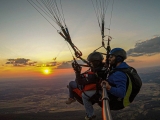
Kitesurfing in Morocco
What makes this country special? It’s home to Essaouira, a stunning location where sports like surfing and kitesurfing are part of daily life. Morocco enjoys warm winds with temperatures rarely exceeding 18-20°C, perfect for water sports. With abundant sunshine and some of the world’s finest beaches—especially windy between March and December—it’s a dream destination.
This means you’ll find ideal conditions for much of the year, with winds sweeping over flat rocky areas. The settings are unmatched: breathtaking beaches, perfect temperatures, and awe-inspiring cultural richness.
Essaouira is nicknamed the "City of Wind", so you can imagine how perfect it is for kitesurfing. Local agencies and guides can organise kitesurfing courses or help seasoned riders find the best spots.

Snowboarding in Morocco
First things first: "djebel" is the Arabic word for mountain ("adrar" in Berber). To broaden your options, here’s a peak in the Rif range—the 2,456m Djebel Tighidine, with its Mediterranean character—and one in the Middle Atlas: Bou Iblane, a perfect complement to a visit to Fez. Then there’s the Toubkal massif, home to some of the region’s highest peaks.
Here are three itineraries to inspire your winter snow adventure:
- Itinerary 1:
Best season: December to March
Recommended start: Asilah de Ketama
Maps: Ketama 1:50,000
This summit offers variable but manageable snow cover. On clear days, you’ll see Sierra Nevada in the distance. The standard ascent route—on skis or snowshoes—is via the north face.
Djebel Tighidine is the Rif’s premier spot for snowboarding and ski touring. Locals often volunteer as guides.

A winding road leads to Ketama (200km from Ceuta), famed for its kif trade. From there, head to Asilah de Ketama village to park. The road reveals the best ascent route, depending on snow cover and preference. If conditions allow, descending through cedar forests is spectacular (mind the stumps!).
Fez is among Morocco’s most captivating cities, while Bou Iblane is the snowy muse of poets—perhaps yearning for lost Granada.
- Itinerary 2:
Best season: December to March
Start point: Bou Iblane Ski Station (closed since ’93)
Maps: Djebel Bou Iblane 1:50,000
From Fez, drive to Bir Tam Tam and Taffert Forest House (barrier). Follow the road to snowline. Slopes from the old station are skiable. Bou Iblane’s SW ridge offers access when snow blocks roads—a historic pass between northern and southern kabilas (villages). Witness locals hauling loads waist-deep in snow, a stark contrast to modern gear. As a Pyrenean villager once remarked: "Not long ago, this was Spain too—my father crossed Breche de Roland in July snow to work in France."
Snowboarding North of the Sahara
Toubkal (pronounced "Tubkal") is Morocco’s iconic peak, though skiers and boarders may prefer neighbours like Ras-N-Ouanoukrim or Timesguida. The refurbished Neltner Hut is the ideal base, easily reached from Imlil.
Hiring a mule for gear is almost mandatory—and a chance to chat with handlers. While 4x4s can go higher, leaving Imlil on foot immerses you in nature. Depending on season and snow, mules may reach the hut; otherwise, porters offer livelihoods without the stigma of handouts.

- Itinerary 3:
Best season: December to March
Start point: Imlil
Maps: Toubkal 1:50,000 (often available in Imlil)
Your mule handler doubles as guide through walnut groves and villages. Rest at Arend Plain and Sidi Chamharouch—a marabout (Muslim hermitage) housing a saint’s tomb ("Sidi" denotes holy men). From here, the hut is within reach. Scout the obvious ascent via Ikhibi South Valley.
Next day, cautiously traverse the icy valley entrance to reach Toubkal’s hanging valley. In good snow, the climb is straightforward. The summit unveils desert vistas, snowy Anti-Atlas peaks, and the Middle Atlas to the north. Tip: if snow permits, extend your stay—the massif deserves days of exploration.












